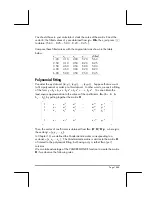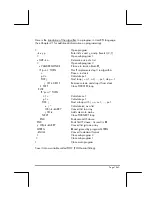
Page 18-58
You should have in your calculator’s stack the value of the matrix X and the
vector b, the fitted values of y are obtained from
y
=
X
⋅
b
, thus, just press
*
to obtain: [5.63.., 8.25.., 5.03.., 8.23.., 9.45..].
Compare these fitted values with the original data as shown in the table
below:
x
1
x
2
x
3
y y-fitted
1.20 3.10 2.00 5.70 5.63
2.50 3.10 2.50 8.20 8.25
3.50 4.50 2.50 5.00 5.03
4.00 4.50 3.00 8.20 8.23
6.00 5.00 3.50 9.50 9.45
Polynomial fitting
Consider the x-y data set {(x
1
,y
1
), (x
2
,y
2
), …, (x
n
,y
n
)}. Suppose that we want
to fit a polynomial or order p to this data set. In other words, we seek a fitting
of the form y = b
0
+ b
1
⋅
x + b
2
⋅
x
2
+ b
3
⋅
x
3
+ … + b
p
⋅
x
p
. You can obtain the
least-square approximation to the values of the coefficients
b
= [b
0
b
1
b
2
b
3
… b
p
], by putting together the matrix
X
_
_
1
x
1
x
1
2
x
1
3
… x
1
p-1
y
1
p
1
x
2
x
2
2
x
2
3
… x
2
p-1
y
2
p
1
x
3
x
3
2
x
3
3
… x
3
p-1
y
3
p
. . . .
. .
. . . . . . .
1
x
n
x
n
2
x
n
3
… x
n
p-1
y
n
p
_
_
Then, the vector of coefficients is obtained from
b
= (
X
T
⋅
X
)
-1
⋅
X
T
⋅
y
, where
y
is
the vector
y
= [y
1
y
2
… y
n
]
T
.
In Chapter 10, we defined the Vandermonde matrix corresponding to a
vector
x
= [x
1
x
2
… x
m
] . The Vandermonde matrix is similar to the matrix
X
of interest to the polynomial fitting, but having only
n
, rather than (
p+1
)
columns.
We can take advantage of the VANDERMONDE function to create the matrix
X
if we observe the following rules:
Содержание 49g+
Страница 1: ...hp 49g graphing calculator user s guide H Edition 4 HP part number F2228 90006 ...
Страница 197: ...Page 5 30 LIN LNCOLLECT POWEREXPAND SIMPLIFY ...
Страница 377: ...Page 11 55 Function KER Function MKISOM ...
Страница 457: ...Page 13 26 In the right hand side figure above we are using the line editor to see the series expansion in detail ...
Страница 775: ...Page 26 10 the location of the backup battery in the top compartment at the back of the calculator ...
Страница 838: ...Page L 5 ...






























